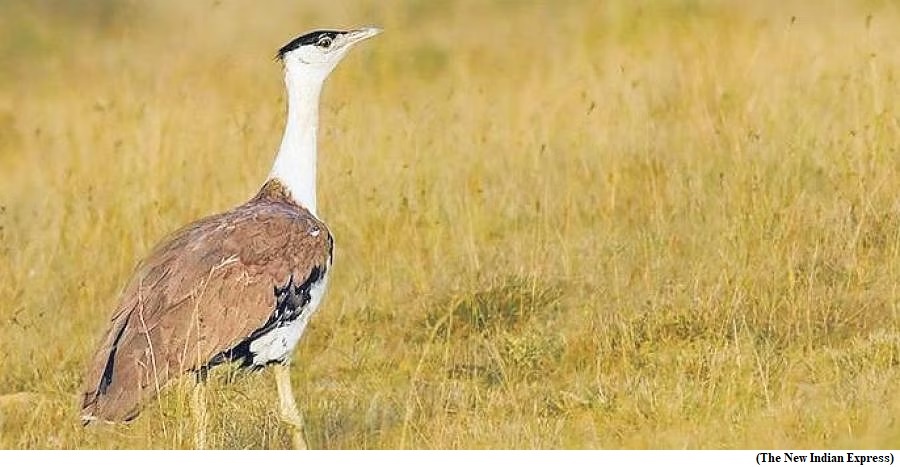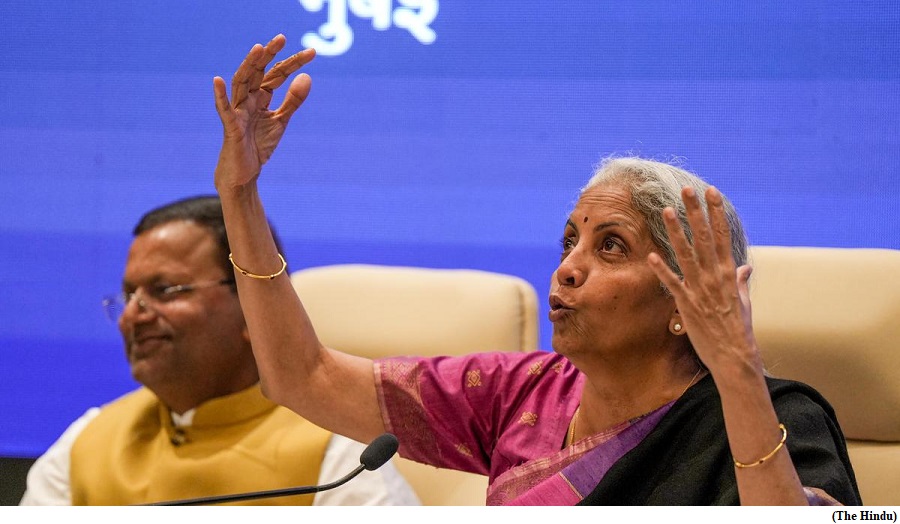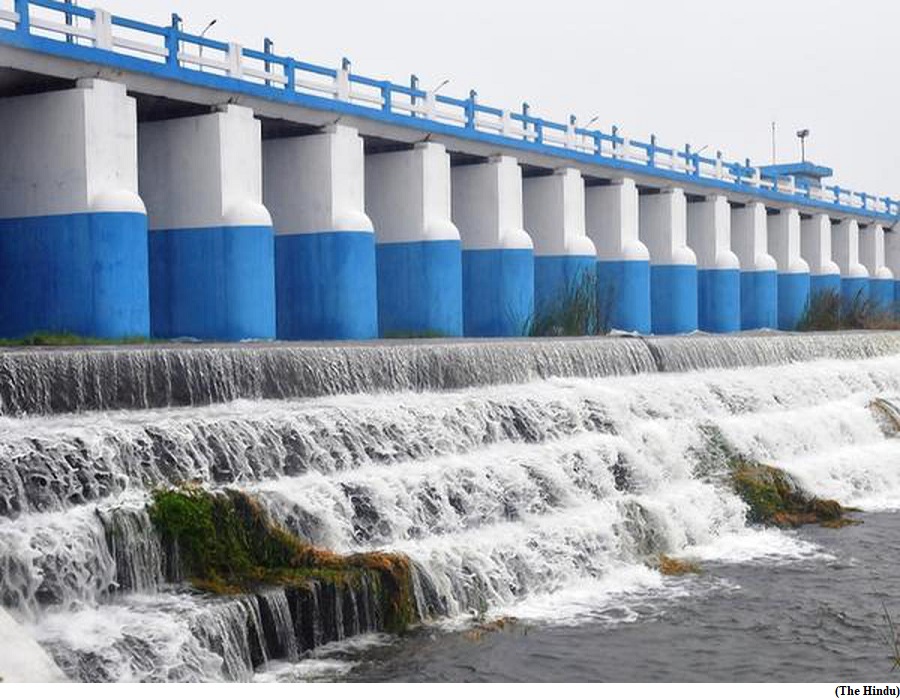Water consumption in textile industry

Why in news?
- Recently, a Supreme Court appointed-committee has recommended that, in order to protect the endangered Great Indian Bustard, close to 800 km, or about 10% of the length of proposed power lines in the Thar and Kutch deserts of Rajasthan and Gujarat should be re-routed or made to go underground.
- Moreover, despite a Supreme Court order directing that low-voltage power lines go underground, no significant steps appear to have been taken by power companies and State governments to comply with them.
Background:
- The nearly 7,200 km of overhead lines are meant to transfer solar power into the grid but existing lines have been harming Great Indian Bustards, which have been dying by colliding into them or getting electrocuted.
- Only about 150 of these birds are still left, most of them in Jaisalmer in Rajasthan.
Bird conservation vs solar power
- The deaths of these birds, and the danger to them from power lines and renewable energy projects, triggered a petition in the Supreme Court in 2019, by environmentalists who asked that all overhead lines be made to go underground.
- Private and public power companies, supported by the Centre’s Ministry of New and Renewable Energy (MNRE), contended that shifting all overhead lines underground would be expensive and impractical, and would significantly hike the cost of solar power, undermining India’s commitment to green growth.
- The Centre has so far sanctioned the development of solar projects with a capacity of nearly 39,000 MW, but only a fourth have actually been commissioned so far.
- In April 2021, the court directed that all low-voltage power lines in areas demarcated as “priority and potential habitats of the Great Indian Bustard” in the Thar and Kutch deserts be pushed underground.
- “Priority zones” are areas where the birds are known to live and “potential regions” are those where conservation programmes, such as breeding the birds in captivity, are ongoing.
Bird diverters:
- High-voltage lines in these zones were also expected to follow suit. However, if power companies found undergrounding technically infeasible, they could approach a Supreme Court-appointed three-member committee for permission to go ahead with overhead lines with modifications.
- These modifications include installing “bird diverters”, which are flaps installed on power lines that work like reflectors and are visible to the flying birds from about 50 metres away, giving them a chance to swerve out of the path of a power line.
- The Great Indian Bustard is a relatively heavy bird, nearly a metre in height, and with frontal vision that makes it hard to avoid collisions.
- Low-voltage lines are more likely to electrocute the birds, but they are more likely to die from high-voltage lines due to collisions. Bird diverters are, however, considered to be a stop-gap measure, as they cannot entirely guarantee an end to bird hits.
About GIB:
- The Great Indian Bustard (GIB), the State bird of Rajasthan, is considered India’s most critically endangered bird.
- It is considered the flagship grassland species, representing the health of the grassland ecology.
- Its population is confined mostly to Rajasthan and Gujarat. Small populations occur in Maharashtra, Karnataka and Andhra Pradesh.
Is the government on track on fiscal deficit targets?
(GS Paper 3, Economy)
Why in news?
- In the Union Budget for 2023-24, Finance Minister chose the path of relative fiscal prudence and projected a decline in fiscal deficit to 5.9% of gross domestic product (GDP) in FY24, compared with 6.4% in FY23.

Details:
- The government planned to continue on the path of fiscal consolidation and reach a fiscal deficit below 4.5% by 2025-26.
- To finance the fiscal deficit in 2023-24, the net market borrowings from dated securities are estimated at ₹11.8 lakh crore, and that the balance financing is expected to come from small savings and other sources. The gross market borrowings are estimated at ₹15.4 lakh crore.
What is the direction on fiscal deficit given in the Budget?
- In Union Budget 2023-24, the fiscal deficit to GDP is pegged at 5.9% in FY24. This ratio has declined from 6.4% in 2022-23 (revised estimate) and 6.7% in 2021-22 (actual).
- In the revenue budget, the deficit was 4.1% of GDP in 2022-23 (revised estimate). In Union Budget 2023-24, revenue deficit is 2.9% of GDP. If interest payments are deducted from fiscal deficit, which is referred to as primary deficit, it stood at 3% of GDP in 2022-23 (RE).
- The primary deficit, which reflects the current fiscal stance devoid of past interest payment liabilities, is pegged at 2.3% of GDP in Union Budget 2023-24.
Are allocations lower for some sectors?
- The major allocations that have been pared down are food, fertilizer and petroleum subsidies.
- The food subsidy in 2022-23 (RE) was ₹2,87,194 crore. In 2023-24, it has been reduced to ₹1,97,350 crore. Similarly, the fertilizer subsidy in 2022-23 was ₹2,25,220 crore (RE); it has been reduced to ₹1,75,100 crore for FY24.
- The petroleum subsidy in 2022-23 was ₹9,171 crore (RE); it has declined to ₹2,257 crore in 2023-24 (Budget estimate/BE). However, the point to be noted is that compared with BE 2022-23, the decline is not that sharp.
- It is a laudable decision to extend food security to the poor for one more year amid rising inflation. However, rationalisation of subsidies is important so that the government can move towards reaching a fiscal deficit target of 4.5% by 2025-26.
What needs to be done for growth?
- The interest rate management by the RBI through inflation targeting alone cannot effectively control inflation, given the supply side shocks. Therefore, fiscal policy measures are crucial to tackle mounting inflation.
- Policy coordination between RBI and North Block is crucial for a sustained growth recovery process. The RBI has been increasing policy rates to tackle mounting inflation. But a high interest rate regime can hurt the economic growth process.
- So, the fiscal policy needs to remain “accommodative” with focus on gross capital formation in the economy with enhanced capital spending, especially infrastructure investment.
- In Budget 23-24, capital spending is expected to rise to 3.3% of GDP. The interest-free loan of ₹1.3 lakh crore for 50 years provided to States should help them spend and boost growth.
Can the govt. stick to fiscal consolidation?
- The Government has not deviated from the path of fiscal consolidation. In Union Budget 2023, the medium-term fiscal consolidation framework stated that there is a need to reduce fiscal deficit-GDP ratio to 4.5% by 2025-26 from the current 6.4%.
- There are revenue uncertainties in post-pandemic times and also geopolitical risks, mounting inflation, supply chain disruptions and energy price volatility. At the same time, the Government has kept the fiscal policy “accommodative”, and has undertaken capital spending to support economic growth recovery.
- The predominant mode of financing fiscal deficit in India is through internal market borrowings. It is also to be financed through securities against small savings, provident funds and an insignificant component of external debt.
- In Union Budget 2023, India’s external debt is pegged at ₹22,118 crore of the total fiscal deficit of ₹17,86,816 crore in 2023-24 (BE), which is approximately about 1%.
- In Union Budget 2023, it is also stated that the States will have to maintain a fiscal deficit of 3.5% of GSDP of which 0.5% will be tied to power sector reforms.
What lies ahead?
- The Finance Minister is focusing on economic growth recovery through capex. She contends that infrastructure investment will boost private investment.
- In the fiscal deficit-GDP ratio, if the denominator GDP expands, it will reduce the overall fiscal deficit-GDP ratio. Her focus is on economic growth recovery to strengthen GDP.
Climate change will increase hydropower generation
(GS Paper 3, Environment)
Why in news?
- Unlike coal-powered power plants, hydropower, which is the second highest power producing source at 13%, is a significant contributor to clean global electricity generation.
- Based on observations and climate projections, a two-member team from IIT Gandhinagar studied the hydroclimatic changes in the catchment areas and their implications for hydropower generation in 46 major dams located in north, central and south India.

Database:
- They looked at the increase in rainfall in the catchment areas and the resultant inflow into all the 46 major reservoirs in the near (2021–2040), mid (2041–2060), and far (2081–2100) periods against the reference period (1995–2014) for two shared socioeconomic pathway scenarios, SSP1-2.6 and SSP5-8.5.
- While SSP1-2.6 is a low-emission scenario, SSP5-8.5 is characterised by high radiative forcing by the end of the 21st century.
Key Findings:
- Based on selected hydroelectric dams, the projected increase in hydropower potential in India is 10-23%.
- A warmer and wetter climate is projected to bring about 5%-33% increased rainfall. As a result, hydropower production is very likely to increase by 9%-36% for most dams and this will come from increased inflow (7-70%) into the dams. The dams in central India show significant increase compared to dams in north and south India.
- Due to global warming, there will be a simultaneous rise in extreme inflow and high reservoir storage conditions for most dams.
- Compared with central and south India, north India is projected to experience higher warming in the future. As per the study, the highest warming (about 5 degree C) is projected for north India, while the warming is projected to be around 3-4 degree C for central and south India.
- Similar to substantial warming, most reservoir catchments are likely to witness increased precipitation due to global warming.
- The study found that inflow to a few dams in Ganga, Mahanadi, Brahmani, and west-coast river basins is projected to decline in the future.
- This reduction in inflow is due to increase in atmospheric water demands in response to the considerable warming compared to increase in precipitation.
Timeline of changes:
- The projected change in hydropower potential is the highest in the far period (-5% to 62.8%) and the lowest for the near period (-6.2% to 39%).
- The potential hydropower generation is projected to rise by more than 50% in Tehri, Ramganga, Kadana, Omkareshwar, Maheshwar, and Sriramsagar dams in the far period.
- In the case of south India, eight out of eleven dams are projected to experience a decline in hydropower potential. Dams in central India are projected to experience a more substantial increase in hydropower generation than north and central India.
- Substantial warming projected for north India may reduce snow and glacial storage, reducing snowmelt water contribution in the long run. But a substantial increase in rainfall is more likely to compensate for the reduction from snowmelt in north India.
Way Forward:
- The findings provide crucial insights into projected changes in hydroclimate and hydropower for the major dams in India.
- India may have to change reservoir rule curves on how much storage should be permitted at different times during the monsoon season.




